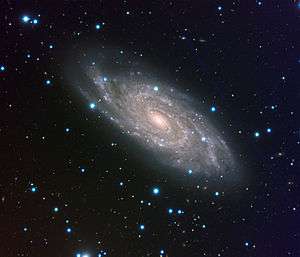NGC 6118
| NGC 6118 | |
|---|---|
|
Almost-true colour image-composite from images made with the Very Large Telescope using its VIMOS imager. | |
| Observation data (J2000 epoch) | |
| Constellation | Serpens |
| Right ascension | 16h 21m 48.6s[1] |
| Declination | −02° 17′ 00″[1] |
| Redshift | 0.005247 (1573 ± 1 km/s)[1] |
| Distance | 82.9 Mly (25.4 Mpc)[2] |
| Apparent magnitude (V) | 12.42[1] |
| Characteristics | |
| Type | SA(s)cd[1] |
| Apparent size (V) | 4.7 x 2.0 arcmin[1] |
| Other designations | |
| PGC 057924 | |
NGC 6118 is a grand design spiral galaxy located 83 million light-years away in the constellation Serpens (the Snake). It measures roughly 110,000 light-years across; about the same as our own galaxy, the Milky Way. Its shape is classified as "SA(s)cd," meaning that it is unbarred and has several rather loosely wound spiral arms. The large numbers of bright bluish knots are active star-forming regions where some very luminous and young stars can be perceived.[3]
Because NGC 6118 has loosely wound spiral open arms, no clear defined spiral arms like the Milky Way galaxy and lacks a central bar, the galaxy thus does not have a galactic habitable zone like the Milky Way.[4][5][6] [7] For the Milky Way, the galactic habitable zone is commonly believed to be an annulus with an outer radius of about 10 kiloparsecs and an inner radius close to the Galactic Center, both of which lack hard boundaries.[6]
NGC 6118 is difficult to see with a small telescope. Amateur astronomers have nicknamed it the "Blinking Galaxy", as it has a tendency to flick in and out of view with different eye positions.[3]
Supernova 2004dk
SN 2004dk was first reported by James Graham and Weidong Li on 1 August 2004. They found the new supernova by studying images produced by the Lick Observatory Supernova Search (LOSS) program with the 76 cm Katzman Automatic Imaging Telescope (KAIT) in San Jose, CA.[8]
SN 2004dk was initially classified by European Southern Observatory astronomer Fernando Patat et al. on 4 Aug 2004 as a Type Ic supernova.[9] Type Ib and Ic supernovae are the end result of massive stars (> 8 solar masses) that have run out of nuclear fuel. Normally one would expect to see evidence of hydrogen and helium, but when these supernova occur in a binary system the companion has sometimes gravitationally stripped the outer layers of the progenitor star away, leaving only the heavier elements. Type Ib supernovae have no hydrogen, while Type Ics have neither hydrogen or helium.
Over the following weeks Alexei Filippenko et al. and the University of California at Berkeley discovered prominent He I absorption lines, thus changing the classification of the supernova to Type Ib.[10]
References
- 1 2 3 4 5 6 "NASA/IPAC Extragalactic Database". Results for NGC 6118. Retrieved 6 Dec 2008.
- ↑ Conselice, C.J. (Nov 1997). "The Symmetry, Color, and Morphology of Galaxies". Publications of the Astronomical Society of the Pacific. 109: 1251–1255. arXiv:astro-ph/9710234
 . Bibcode:1997PASP..109.1251C. doi:10.1086/134004.
. Bibcode:1997PASP..109.1251C. doi:10.1086/134004. - 1 2 "Explosions in Majestic Spiral Beauties: Very Large Telescope Takes Snapshots of Two Grand-Design Spiral Galaxies". European Southern Observatory. 1 Dec 2004. Retrieved 6 Dec 2008.
- ↑ Universe Today, Supernova in a Distant Galaxy NGC 6118, 24 Mar , 2012, by Fraser Cain
- ↑ Astro Photo Lab, The Blinking Galaxy
- 1 2 Gowanlock, M. G.; Patton, D. R.; McConnell, S. M. (2011). "A Model of Habitability Within the Milky Way Galaxy". Astrobiology. 11 (9): 855–873. arXiv:1107.1286
 . Bibcode:2011AsBio..11..855G. doi:10.1089/ast.2010.0555. PMID 22059554.
. Bibcode:2011AsBio..11..855G. doi:10.1089/ast.2010.0555. PMID 22059554. - ↑ Choi, Charles Q. (21 August 2015). "Giant Galaxies May Be Better Cradles for Habitable Planets". Space.com. Retrieved 24 August 2015.
- ↑ "Supernova 2004dk in NGC 6118". International Astronomical Union Circular 8377. Smithsonian Astrophysical Observatory. 2 Aug 2004. Retrieved 2011-07-05.
- ↑ "Supernova 2004dk in NGC 6118". International Astronomical Union Circular 8379. Smithsonian Astrophysical Observatory. 4 Aug 2004. Retrieved 2011-07-05.
- ↑ "Supernovae 2004dk, 2004dw, 2004dy, AND 2004eg". International Astronomical Union Circular 8404. Smithsonian Astrophysical Observatory. 11 Sep 2004. Retrieved 2011-07-05.
Coordinates: ![]() 16h 21m 48.6s, −02° 17′ 00″
16h 21m 48.6s, −02° 17′ 00″
